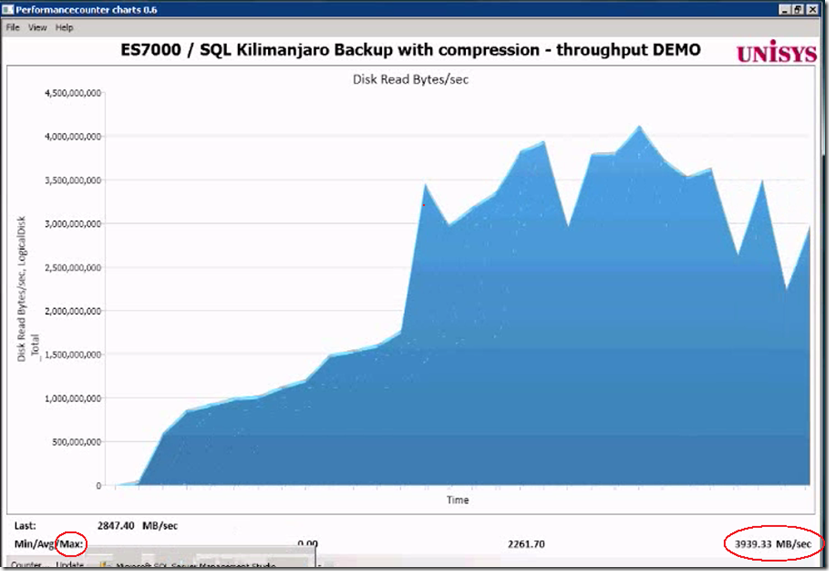怎么样快速完整备份和压缩 很大的 sqlserver 1TB 数据库 -摘自网络
How to increase SQL Database Full Backup speed using compression and Solid State Disks
The SQL 2008 Database backup compression feature (which was introduced as a SQL2008 Enterprise Edition only feature) will become available in the SQL2008 R2 Standard Edition also (SQL 2008 R2 Editions). I’m using the compression feature for quite some time now and really love it; it saves significant amounts of disk space and increases the backup throughput. And when such a great feature is available I would recommend you to use it! In the following walk through I will show you some simple tricks to speed up the backup throughput.
How fast can we run a Full Backup on a single database with a couple of billion rows of data, occupying a couple hundred Gigabytes of disk space, spread across multiple Filegroups?
Of course your server will use some extra CPU cycles to compress the data on the fly and will use the maximum available IO bandwidth. For that purpose I tested on some serious hardware with plenty of both: a 96 core Unisys ES7000 model 7600R with 2 DSI Solid State Disk units who deliver a total of 6+ GB/sec IO throughput.
Getting started with Database Backup Compression
Database backup compression is disabled by default and it can be enabled through the SSMS GUI or by adding the word “COMPRESSION” to a T-SQL backup query.
Through SSMS, when you -right click- the database which you would like to backup, under –Tasks- , -Back Up…-, -Options-, at the bottom , you will find the Compression feature. (see pictures)
After you have selected the “Compress Backup” option, click the –Script- Option to generate the TSQL statement. Please note that the word COMPRESSION is all you need to enable the feature from your backup query statement.


To enable backup compression feature for all your databases as the default option, change the default with the following sp_configure command:
GO
EXEC sp_configure backup compression default, '1';
RECONFIGURE WITH OVERRIDE
Step1 : Measure the “Out of the box” throughput
By running the above query, as a result, more than 1400 MByte/sec is read on average from both the DSI Solid State disks. That’s like reading all data from 2 full cd-rom’s each second. Not bad!

Waitstats
The SQL Waitstats show that the number 1 wait_type is BACKUPBUFFER.
The MSDN explanation for the BACKUPBUFFER wait_type is interesting: “the backup task is waiting for data or is waiting for a buffer in which to store data. This type is not typical, except when a task is waiting for a tape mount”. ehhh ok… since we are not using tapes , it means that this is not typical ! Let’s see what we can find out about the buffers.

Traceflag
To get more insights in the backup settings there are 2 interesting traceflags. With these traceflags enabled the actual backup parameters are logged into the SQL “Errorlog “.
DBCC TRACEON (3213, –1)
The Errorlog show that our backup was using 9 Buffers and allocated 9 Megabyte of buffer space.
9 MByte seems a relative low value to me to queue up all the destination backup file data and smells like an area where we can get some improvement, (especially since we have we have 16 x 4Gbit fiber cables and 6+ GigaByte/sec of IO bandwidth waiting to get saturated ;-) ).

Step2: Increase throughput by adding more destination files
A feature that not many people know is the option to specify multiple file destinations to increase the throughput:

To add multiple Backup destination files in the query, add them like this:
DBCC TRACEON (3605, –1)
DBCC TRACEON (3213, –1)
BACKUP DATABASE [TPCH_1TB]
TO
DISK = N'C:\DSI3400\LUN00\backup\TPCH_1TB-Full',
DISK = N'C:\DSI3500\LUN00\backup\File2',
DISK = N'C:\DSI3500\LUN00\backup\File3',
DISK = N'C:\DSI3500\LUN00\backup\File4',
DISK = N'C:\DSI3500\LUN00\backup\File5',
DISK = N'C:\DSI3400\LUN00\backup\File6',
DISK = N'C:\DSI3500\LUN00\backup\File7',
DISK = N'C:\DSI3500\LUN00\backup\File8',
DISK = N'C:\DSI3500\LUN00\backup\File9'
WITH NOFORMAT, INIT,NAME = N'TPCH_1TB-Full Database Backup',
SKIP, NOREWIND, NOUNLOAD, COMPRESSION, STATS = 10
DBCC TRACEOFF(3605, –1)
DBCC TRACEOFF(3213, –1)
Result of adding 8 more destination files: the throughput increases from 1.4 GB/sec up to 2.2- 2.4 GB/sec.
That’s a quick win to remember!

The SQL Errrorlog with the buffer configuration parameters shows that extra buffers are added automatically.

Step3 : Set Backup parameters options
The Backup/Restore buffer configuration parameters show some interesting parameters and values!
Time to start reading the ehh documentation! When you highlight the word ‘Backup’ and you hit <Shift-F1> you can read more on the topic; there are 2 Data Transfer Options listed :
BUFFERCOUNT and MAXTRANSFERSIZE.
BUFFERCOUNT : specifies the total number of I/O buffers to be used for the backup operation.
The total space that will be used by the buffers is determined by: buffercount * maxtransfersize.
The output shows this is correct; with 49 buffers * 1024 KB = 49 MB total buffer space is in use.
MAXTRANSFERSIZE : specifies the largest unit of transfer in bytes to be used between SQL Server and the backup media.
The possible values are multiples of 64 KB ranging up to 4194304 bytes (4 MB). The default is 1 MB.
a 3rd option is listed under the section Media Set Options:
BLOCKSIZE : specifies the physical block size, in bytes. The supported sizes are 512, 1024, 2048, 4096, 8192, 16384, 32768, and 65536 (64 KB) bytes.The default is 65536 for tape devices and 512 otherwise.
Trial and Measure approach
By using the famous “Trial and Measure” approach, I found that the selecting the maximum value for Blocksize (65535) and doubling the MAXTRANSFERSIZE to (2097152) works best. also a BUFFERCOUNT of 2200 , allocating a buffer of 4400 MB total works best to get the maximum throughput;
DBCC TRACEON (3605, –1)
DBCC TRACEON (3213, –1)
BACKUP DATABASE [TPCH_1TB]TO
DISK = N'C:\DSI3400\LUN00\backup\TPCH_1TB-Full',
DISK = N'C:\DSI3500\LUN00\backup\File2',
DISK = N'C:\DSI3500\LUN00\backup\File3',
DISK = N'C:\DSI3500\LUN00\backup\File4',
DISK = N'C:\DSI3500\LUN00\backup\File5',
DISK = N'C:\DSI3400\LUN00\backup\File6',
DISK = N'C:\DSI3500\LUN00\backup\File7',
DISK = N'C:\DSI3500\LUN00\backup\File8',
DISK = N'C:\DSI3500\LUN00\backup\File9'
WITH NOFORMAT, INIT,NAME = N'TPCH_1TB-Full Database Backup',
SKIP, NOREWIND, NOUNLOAD, COMPRESSION,STATS = 10
— Magic:
,BUFFERCOUNT = 2200
,BLOCKSIZE = 65536
,MAXTRANSFERSIZE=2097152
GO
DBCC TRACEOFF(3605, –1)
DBCC TRACEOFF(3213, –1)
Result: the average throughput is more then doubled, and the maximum peak throughput is up to 3939 MB/sec !

BLOCKSIZE
An interesting observation is that I was more less expecting to see that by changing theBLOCKSIZE would also show up in the log, but it doesn’t .
Also the “Filesystem I/O alignment” value remained the same:

By coincidence, (I forgot to delete the backup files when adding some more destination files,) I found out that the blocksize value does make a change by looking at the error message:
Cannot use the backup file 'C:\DSI3500\LUN00\dummy-FULL_backup_TPCH_1TB_2' because
it was originally formatted with sector size 65536
and is now on a device with sector size 512.
Msg 3013, Level 16, State 1, Line 4
BACKUP DATABASE is terminating abnormally.
By specifying a large 64KB sector size instead of the default 512 bytes typically shows an 5-6% improvement in backup throughput.
BACKUP to DISK = ‘NUL’
To estimate and check how fast you can read the data from a database or Filegroup there is a special option you can use to backup to: DISK = ‘NUL’. You only need 1 of those !
FILEGROUP = 'SSD3500_0',
FILEGROUP = 'SSD3500_1'
TO DISK = 'NUL'
WITH COMPRESSION
, NOFORMAT, INIT, SKIP, NOREWIND, NOUNLOAD
, BUFFERCOUNT = 2200
, BLOCKSIZE = 65536
, MAXTRANSFERSIZE=2097152
Wrap-Up
Backup compression is a great feature to use. It will save you disk capacity and reduce the time needed to backup your data. SQL can leverage the IO bandwidth of Solid State storage well but to achieve maximum throughput you need to do some tuning. By adding multiple backup destination files and specifying the BUFFERCOUNT, BLOCKSIZE and MAXTRANSFERSIZE parameters you can typically double the backup throughput, which means reducing the backup time-taken by half!
怎么样快速完整备份和压缩 很大的 sqlserver 1TB 数据库 -摘自网络的更多相关文章
- MariaDB之基于Percona Xtrabackup备份大数据库[完整备份与增量备份]
MariaDB之基于Percona Xtrabackup备份大数据库[完整备份与增量备份] 1.Xtrabackup的安装 percona-xtrabackup-2.2.3-4982.el6.x86_ ...
- Percona Xtrabackup备份mysql大数据库(完整备份与增量备份)
Percona Xtrabackup备份mysql大数据库(完整备份与增量备份) 文章目录 [隐藏] Xtrabackup简介 Xtrabackup安装 Xtrabackup工具介绍 inno ...
- Percona Xtrabackup备份mysql全库及指定数据库(完整备份与增量备份)
原文地址:http://www.tuicool.com/articles/RZRnq2 Xtrabackup简介 Percona XtraBackup是开源免费的MySQL数据库热备份软件,它能对In ...
- postgresql-定时备份,压缩备份
crontab -e 在最后添加: # backup database at 22:00 every day 0 22 * * * thunisoft /home/eric/bin/backup-db ...
- Percona备份mysql全库及指定数据库(完整备份与增量备份)
Percona Xtrabackup备份mysql全库及指定数据库(完整备份与增量备份) Xtrabackup简介 Percona XtraBackup是开源免费的MySQL数据库热备份软件,它能对I ...
- 快速幂取模(当数很大时,相乘long long也会超出的解决办法)
当几个数连续乘最后取模时,可以将每个数字先取模,最后再取模,即%对于*具有结合律.但是如果当用来取模的数本身就很大,采取上述方法就不行了.这个时候可以借鉴快速幂取模的方法,来达到大数相乘取模的效果. ...
- Linux完整备份工具 - dump, restore(现在基本不用这两个)
dump 其实 dump 的功能颇强,他除了可以备份整个文件系统之外,还可以制定等级喔!什么意思啊! 假设你的 /home 是独立的一个文件系统,那你第一次进行过 dump 后,再进行第二次 dump ...
- 阿里云 如何减少备份使用量? mysql数据库的完整备份、差异备份、增量备份
RDS for MySQL备份.SQL审计容量相关问题_MYSQL使用_技术运维问题_云数据库 RDS 版-阿里云 https://help.aliyun.com/knowledge_detail/4 ...
- sql server 数据库备份,完整备份,差异备份,自动备份说明
Sql server 设置完整备份,差异备份说明 在数据库管理器中,选择要备份的数据库,右键找到“备份” 然后可以按照备份的方式进行备份. 关于文件的还原,作以下补充说明: 步骤为: 1.在需要还原的 ...
随机推荐
- jQuery CircleCounter的环形倒计时效果
在线演示1 本地下载 使用jQuery插件CircleCounter生成的环形倒计时效果,这个插件使用HTML5画布生成动画效果,还不错,大家可以试试! 顺带手录制了个代码,大家不吝赐教:http:/ ...
- VM虚拟机启动报错Reason Failed to lock the file怎么办
VMware启动报错Reason: Failed to lock the file的解决方法 症状: 启动VMware虚拟机的时候出现了Cannot open the disk '*.vmdk' o ...
- UE如何将某些字符替换成换行
如下所示,我想要在所有;后面加个回车 就把;替换成;^r^n 效果如下所示
- 消息队列的使用场景(转载c)
作者:ScienJus链接:https://www.zhihu.com/question/34243607/answer/58314162来源:知乎著作权归作者所有.商业转载请联系作者获得授权,非商业 ...
- ios8 xcode6 下的启动界面设置和图标设置
IOS8 我试了网上不少设置启动动画的,不知道是不是我弄错了还是怎么的,反正启动不了,后来在code4论坛找到了这个: 启动屏幕:LaunchScreen.xib文件 桌面图标等相关app图片:Ima ...
- WebService 之 已超过传入消息(65536)的最大消息大小配额。若要增加配额,请使用相应绑定元素上的 MaxReceivedMessageSize 属性。
在使用 WCF 中,遇到如下问题: 已超过传入消息(65536)的最大消息大小配额.若要增加配额,请使用相应绑定元素上的 MaxReceivedMessageSize 属性. 问题说明: 客户端调用 ...
- DataGrid前台数据绑定技巧
(1)DataGrid控件不换行,数据显示不完全后面加"..." <%# DataBinder.Eval(Container.DataItem,? DataBinder.Ev ...
- Android模拟神器——Genymotion
文章地址:http://ryantang.me/blog/2013/08/16/genymotion/
- 解决RMI 客户端异常no security manager: RMI class loader disabled
解决方法: 客户端和服务端的Service包名改一致 ok!!
- 解决document.location.href下载文件时中文乱码
1:tomcat 安装路径下 找到 conf文件下的server.xml 2:<Connector port="8080" URIEncoding="utf-8&q ...

